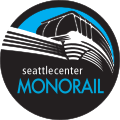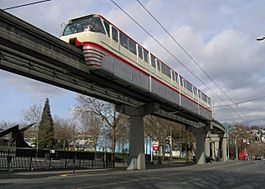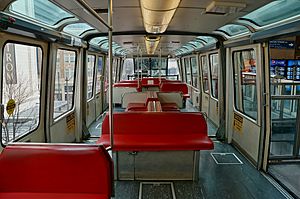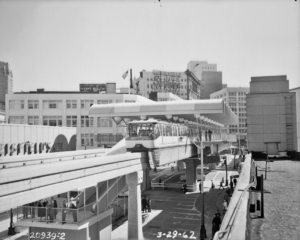Seattle Center Monorail facts for kids
Quick facts for kids Seattle Center Monorail |
|
|---|---|
 |
|

The red monorail train passing over 5th Avenue
|
|
| Overview | |
| Owner | City of Seattle |
| Locale | Downtown Seattle, Washington, U.S. |
| Termini | Seattle Center (north) Westlake Center (south) |
| Stations | 2 |
| Website | seattlemonorail.com |
| Service | |
| Type | Straddle-beam monorail |
| Operator(s) | Seattle Monorail Services |
| Rolling stock | 2 Alweg trains |
| Daily ridership | 7,056 (2023) |
| Ridership | 2,134,977 (2023) |
| History | |
| Opened | March 24, 1962 |
| Designated: | August 4, 2003 |
| Technical | |
| Line length | 0.9 miles (1.4 km) |
| Number of tracks | Double |
| Character | Elevated |
| Electrification | Contact rails, 700 V DC |
| Operating speed | 45 mph (72 km/h) |
The Seattle Center Monorail is a special train system in Seattle, Washington, United States. It's an elevated train, meaning it runs high above the ground on a single, wide beam. This type of train is called a monorail.
The monorail track is about 0.9-mile (1.4 km) long. It travels along 5th Avenue between the Seattle Center and Westlake Center in Downtown Seattle. There are no stops in between these two main stations.
It's a popular tourist attraction and also a regular public transit service. Trains usually run every ten minutes for up to 16 hours a day. The entire trip from one end to the other takes only about two minutes.
In 2023, over 2.1 million people rode the monorail. It often makes a profit, which is shared between the company that runs it and the city government.
The monorail was built very quickly, in just eight months. It cost $4.2 million for the 1962 Century 21 Exposition, which was a world's fair held at the Seattle Center. The system still uses its original two Alweg trains from the world's fair. Each train can carry up to 450 people.
The City of Seattle owns the monorail. In 2003, the city officially recognized the tracks and trains as a historic landmark. A private company has been operating the system since 1994.
Over the years, people have suggested making the monorail system much bigger. However, these plans, like the Seattle Monorail Project, faced money problems and were eventually canceled.
Contents
Exploring the Monorail Route and Stations
The monorail's 0.9-mile (1.4 km) journey starts at the Seattle Center. This is a big park and complex located northwest of Downtown Seattle. The Seattle Center station is near famous spots like the Space Needle and the Museum of Pop Culture.
This station is raised above the ground. It has three platforms: two side platforms for people getting off and a center platform for people getting on. The trains' repair area is right below the platforms.
From the Seattle Center, the tracks turn south. They even pass right through the Museum of Pop Culture building! This museum was designed to have the monorail tracks go through it.
The tracks then cross Broad Street and follow 5th Avenue North. They pass by the KOMO Plaza news center. The monorail columns divide 5th Avenue into two lanes for cars.
As the monorail continues, it passes other city landmarks. These include the Amazon Spheres and the Westin Seattle towers.
The southern end of the line is at the Westlake Center shopping mall. This station is on the third floor of the mall. You can take an elevator directly to the street or to the Westlake tunnel station. This tunnel station serves Link light rail trains.
How to Ride: Service and Fares
The monorail trip between the Seattle Center and Westlake Center takes about two minutes. Trains leave each station every 10 minutes. Usually, only one train runs at a time.
The monorail has different schedules for different seasons. In autumn and winter (September to May), trains run for 13–14 hours on weekdays. On Fridays and Saturdays, they run until 11:00 p.m. On Sundays, they run for 12 hours, ending at 9:00 p.m.
The summer schedule (May to September) has longer hours. Weekday trains run for 16 hours, and weekend trains for 15 hours. Service ends at 11:00 p.m. every day during the summer.
The monorail usually has fewer trains on national holidays. It is completely closed on Thanksgiving Day and Christmas. For big events at the Seattle Center or Climate Pledge Arena, hours are extended. Trains also run more often, every four minutes, using both trains.
You pay for your ride at turnstiles at either station. You can use an ORCA card, a phone app, or paper tickets. Tickets can be bought from a vending machine using credit/debit cards or mobile payments.
As of 2025, a one-way ticket costs $4 for adults. For young people aged 6–18, it's $2. Children aged five and under ride for free. Special reduced rates are also available for seniors, people with disabilities, and U.S. military members.
In October 2019, the monorail started accepting ORCA cards. This is the payment system used for other public transport in the region. Since May 2023, youth ORCA cards allow free rides for anyone 18 or younger.
How the Monorail Works

A private company called Seattle Monorail Services (SMS) runs the monorail. This company was started in 1994. Before that, the city and the county's public transit system operated it.
The monorail does not get money from public taxes for its daily operations. It covers its costs using ticket sales. This is unusual for public transport in the U.S. The company and the city share any profits equally.
In 2022, about 2.1 million people rode the monorail. Ridership went down during the COVID-19 pandemic. But it bounced back in 2022 and 2023, especially with the opening of Climate Pledge Arena. Tickets to events at the arena often include free monorail rides.
The Trains and Tracks
The monorail runs on a special track that is completely elevated. It is supported by 68 hollow columns that can be up to 30 feet (9.1 m) tall. The two parallel tracks sit on strong concrete beams. These beams are about 70 ft (21 m) long and 5 ft (1.5 m) tall.
The system has two aluminum trains: the "Blue Train" and the "Red Train." They were built in 1962 in West Germany. They have been running on the line ever since! Each train is 122 ft (37 m) long and can hold 450 passengers.
Each train uses 64 rubber tires. Sixteen tires on top of the beam carry the train's weight. The other 48 tires on the sides help guide the train.
Even though the system was designed to drive itself, human operators control the trains. They use a joystick and LCD screens to see important information. The trains get their power from a third rail that carries 700 volts of electricity. They can reach speeds of up to 45 mph (72 km/h).
Monorail History: From World's Fair to Today
People in Seattle thought about building monorails even in the early 1900s. But these early ideas never became real.
In the 1950s, Seattle planned its second World's Fair. This fair was called the Century 21 Exposition. A monorail was suggested to connect downtown hotels to the fairgrounds. This would make it easy for visitors to get around.
The German company Alwac International offered to build the monorail. They would pay for it themselves and collect fares. If they made back their $3.5 million cost, the city would own the system. If not, it would be taken down.
Building the Monorail
Construction of the monorail began in April 1961. The local company Howard S. Wright Construction Company helped build it. This company also built the famous Space Needle.
The concrete columns were put up first. Then, the large concrete beams for the tracks were brought in from Tacoma. The two monorail trains were built in West Germany.
The first train, the "Blue Train," arrived in Seattle in February 1962. It had its first test run on March 3. The second train, the "Red Train," arrived in late March.
The World's Fair Opening
The monorail opened to the public on March 24, 1962. This was a month before the World's Fair officially started. On its first day, about 9,600 people rode the Blue Train.
The Century 21 Exposition officially opened on April 21. During the fair, the monorail carried 7.4 million passengers. This was about 90 percent of all fair visitors! Famous people like astronaut John Glenn even rode it.
The money from ticket sales quickly covered the $4.2 million building cost. After the fair, the city government decided to keep the monorail. It officially took ownership in May 1965.
Changes and Updates
In 1973, the county's public transit system, Metro Transit, took over operating the monorail. The trains even got new paint jobs in 1978. The red train became the green train for a while!
A big change happened in 1988. The southern station at Westlake Mall was moved and rebuilt. It became part of the new Westlake Center shopping mall. This project was complicated and took several months to complete. The new Westlake Center monorail station finally opened in February 1989.
In 1994, a private company, Seattle Monorail Services, took over operations. Around 2000, the Museum of Pop Culture was built. It was designed so the monorail tracks would pass right through the middle of the building.
In 2003, the monorail tracks and trains were named a historic landmark. This helps protect them for the future.
The monorail had to close for a while in March 2020 due to the COVID-19 pandemic. Ridership dropped a lot that year.
Modern Station Upgrades
In October 2019, the monorail started accepting ORCA cards. This made it easier for people to pay.
In 2021, the monorail stations were renovated. This was to prepare for the opening of Climate Pledge Arena. The Westlake Center station was made bigger to handle more people. This project was funded by private money and a federal grant. The Seattle Center station is also planned for future renovations.
Since the arena opened, more people are riding the monorail. In 2023, some of the monorail columns on 5th Avenue were painted with portraits of baseball players. This was to celebrate the 2023 Major League Baseball All-Star Game in Seattle. More columns were decorated in 2024 with artwork from local students.
Ideas for Expanding the Monorail
Over the years, many people have suggested making the monorail system much larger. In 1961, one businessman proposed extending it north and south to other cities. Other ideas included connecting Seattle to the airport.
In the 1970s, there were plans for a citywide monorail network. One idea was for an 83-mile (134 km) system with 41 stations. However, these plans never moved forward.
In the late 1990s, a new idea for a citywide monorail system gained support. Voters approved a plan to build an X-shaped system. This "Green Line" would connect different parts of Seattle.
However, this project faced many challenges. Costs grew much higher than expected. After several votes, the plan was finally canceled in 2005. The group working on it was officially closed in 2008. Some of the ideas from this monorail plan were later used for future light rail projects.
Safety on the Monorail
Like any transportation system, the monorail has had a few incidents over its long history. Safety is always a top priority.
In October 1962, a train hit a bumper at the Westlake station. No one was hurt, but the train was damaged. In July 1971, a train hit a girder at the Seattle Center station due to a brake issue. Some passengers had minor injuries.
In May 2004, a fire started on the blue train while it was moving. About 150 people were on board. Firefighters helped everyone get off safely. The fire was caused by an electrical problem. Both trains were repaired and returned to service.
In November 2005, the two monorail trains touched each other near the Westlake Center station. This happened because a driver did not yield properly. Passengers were safely evacuated. The trains needed extensive repairs, which took several months.
See also
 In Spanish: Monorriel de Seattle para niños
In Spanish: Monorriel de Seattle para niños
- Transportation in Seattle
- List of monorail systems




